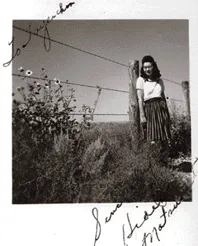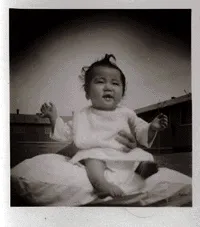Internee's Album Pages
Contributed by various internees
Granada Relocation Camp (Amache), Colorado
From the collection of A Collection of Photographs from Amache
circa 1942-1945
About
The Amache Relocation Camp, officially known as the Granada War Relocation Center, was unique among the internment camps for its remarkable agricultural achievements and its unusual relationship with the nearby town of Granada. The internees transformed the arid Colorado landscape through irrigation, introducing new varieties of vegetables and fruits previously unknown to the region.
The photographs from Amache reveal a complex interplay between documenting confinement and asserting dignity. When internees posed in their best clothes by the barbed wire fence or arranged formal portraits against barrack walls, they were not merely taking snapshots - they were creating evidence that spoke to both their imprisonment and their determination to maintain their humanity. These images, taken with borrowed or smuggled box cameras, transform even casual poses into powerful statements: each carefully composed photograph, each subject in formal dress, represents an act of resistance against dehumanization. The practice of exchanging these photos among friends adds another layer of meaning - creating a network of shared memories that preserved both individual dignity and community bonds.
Photography at Amache captured both the harsh realities of camp life - evident in images of guard towers and barbed wire fences - and the resilient spirit of the community. Internees used creative techniques like photo collage to document their surroundings, creating panoramic views that provided a broader perspective of the camp's layout and scale.
The camp's legacy continues through educational initiatives, with former internees sharing their experiences with Colorado high school students. These photographs serve not only as personal mementos but as powerful historical documents that help tell the story of Amache to new generations.
Photographs

Photo collage became a way of photographing a panoramic photo of the camp. This is from the guard tower. Note the continuation of the guard tower on the left hand photo. Amache was located in the middle of southern Colorado farmland. The internees brought in irrigation and farmed vegetables and fruits never seen in this region before. There was alot of interaction with the small town people of Granada and the camp internees. A reversal, the town people were even allowed to shop in the Amache camp canteen on the weekends. The reunions here introduce the Granada High School history students to returning internees and their stories and memories. They go from school to school in Colorado to talk about this camp. This collage technique does more than document the camp's physical layout - it provides crucial evidence of the scale of incarceration while demonstrating the photographers' determination to fully capture their experience despite technical limitations. The inclusion of guard towers in these panoramas ensures that future generations would understand the true nature of these 'relocation centers.'

To remember friendships made within the camps friends exchanged photos. One unique pose to the camps is leaning against the barbed wire fense. The juxtaposition in this image is striking and deliberate - friends in formal dress posed against the camp's barbed wire. What might appear as a casual snapshot was actually a sophisticated choice: documenting both the maintenance of dignity through careful dress and presentation, while ensuring that evidence of their imprisonment was unmistakably preserved. This became a distinctive visual language of the camps, where even friendly poses carried deeper meaning.

The trusty box camera documents this uplifted baby on a pillow. It appears that the photographer is trying to block the sun with his/her hand. Even in documenting life's tender moments, like this baby portrait, the photographers maintained formal composition despite challenging conditions. The careful arrangement on the pillow and the photographer's effort to control harsh sunlight demonstrate how internees worked to preserve dignity and normalcy in their visual records, even while imprisoned.